Becoming a strategic hero: expert insights on audience intelligence best practices and challenges
Audience intelligence means everything when we talk about success in the agency world. It’s now responsible for enhancing so many marketing functions, like building winning marketing strategies, precision audience targeting, and creating content that resonates.
Agencies rely on audience intelligence platforms for every new client pitch and use it for every client project.
It’s no longer a “nice to have”, it’s a need to have, therefore you will find it in every agency's tech stack.
So if every agency uses audience intelligence, what makes one more competitive than the other? The answer is how they use audience intelligence.
We spoke to the top industry experts to impart their wisdom on us about the best practices and challenges when it comes to audience intelligence.
In this article, we’ve summarized their knowledge to equip agencies with the information and strategies they need to leverage audience intelligence platforms to the fullest.
The evolving role of audience intelligence in agencies
Historical perspective
Audience intelligence as it pertains to marketing has evolved over several decades, and its roots can be traced back to the early days of market research. Back then, audience intelligence referred to the data collected by means of surveys, focus groups, and demographic data. This is what agencies used to understand target audiences better.
Everything changed in the digital age, and audience intelligence became a lot more accessible. Now marketers have consumer data sourced from the web, social media, and ad platforms. The insights derived from this new method, made the data collected from focus groups look less accurate and outdated.
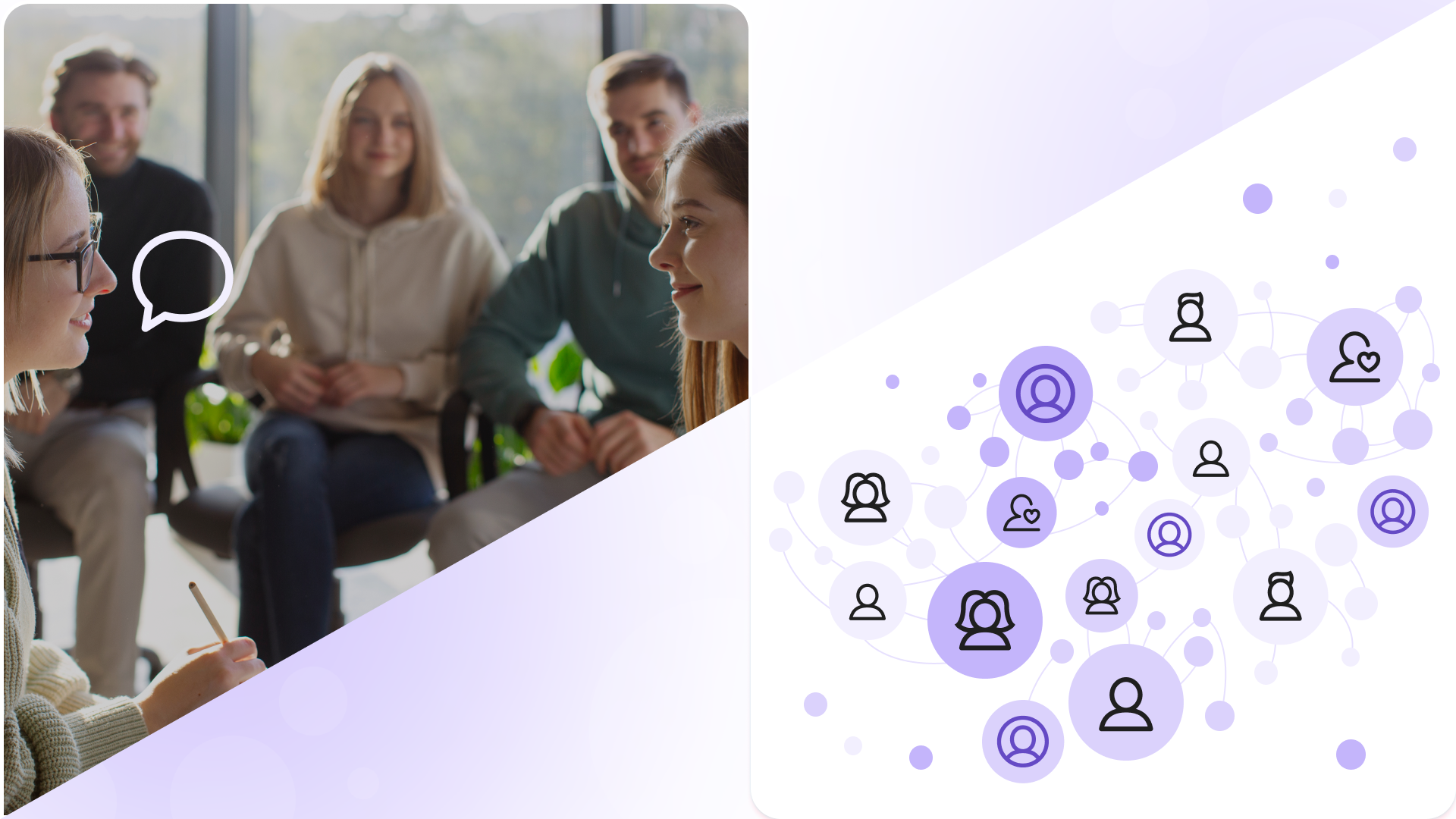
Not to mention, the amount of time, money and resources used for focus groups was now a fraction of that.
In the present day, Marketers have an overwhelming amount of data on consumer behavior, interests and preferences.
Experienced marketers, like expert Mike White, the CEO of Lively agency, have got to witness this evolution of audience intelligence firsthand.
“Audience intelligence has come a long way since I started in Marketing. Agencies used to take on the challenge of doing it themselves from desktops. Then, the focus groups began. Now, it's all about the data. Marketing ideas used to be built of instinct, and now they are built based on so many different factors and data points, thanks to audience intelligence tools.”
Even in the last couple years audience intelligence has rapidly evolved. Jeremy Hollow, Founder and CEO of Listen + Learn Research weighed in on the more recent changes he’s seen.
 “The last few years have seen a profound shift in how consumers make purchases. The continued rise of the creator economy has introduced powerful new influences at each stage of the path to purchase. Consumer attention has also shifted from traditional media to social media platforms like TikTok, Instagram, and YouTube.
“The last few years have seen a profound shift in how consumers make purchases. The continued rise of the creator economy has introduced powerful new influences at each stage of the path to purchase. Consumer attention has also shifted from traditional media to social media platforms like TikTok, Instagram, and YouTube.
This shift has made a huge impact on how we find, understand and target our audiences in the present day. Standard demographic-led media planning doesn’t cut it anymore, and can't reach these new, more social audiences.”
Current landscape
In the current agency landscape, Audience intelligence has become a vital tool in effective campaign planning, execution, and measurement.
“Audience intelligence has always played an integral role in strategic planning. Historically, that data came from primary research. Today, and with the rise of social media, data from the platforms can now provide insights to inform strategic planning and campaign development. This will only become more relevant across all channels.” - Michael Brito, Global Head of Analytics at Zeno Group.
came from primary research. Today, and with the rise of social media, data from the platforms can now provide insights to inform strategic planning and campaign development. This will only become more relevant across all channels.” - Michael Brito, Global Head of Analytics at Zeno Group.
Nowadays, audience intelligence tools have become so efficient that they can present audience insights in real time.
“This is important because insights like audience demographics, cultural backgrounds, habits, top channels and social platforms can be surfaced as fast as audience habits change, which feels like on a daily basis.” says Lively Agency CEO Mike White.
Future outlook
Audience intelligence will no doubt continue to transform agency operations.
Mike believes that “Audience intelligence technology will continue to advance to become more customizable, and better fit the specific needs of every different agency brief.”
Expert insights on best practices
No matter how many advances there are to audience intelligence, it won’t matter if agencies don’t know how to use it in the right way, or know how to use audience intelligence tools to their fullest potential.
So here are experts Hannah Humpherson, Account Director at Convosphere, Mike, and Michael’s audience intelligence best practices.
Data integration and management
When it comes to integrating and managing all the audience data, agencies need a solid strategy to achieve a comprehensive view of their client's audience.
Mike White suggests:
- “Ask your client to tell you about their audience first before diving into the data. Don't underestimate how much they already know about their audiences that could help you paint a fuller picture.”
- “Some simple tools such as ChatGPT can be an easy start in the process of collecting audience data, however, this should be a starting point to collecting information on the demographic you are looking at, as the data needs fact-checking,”
- “When it comes to external data sources, if the client does not already employ them, an audience intelligence tool like Audiense is your number one first stop.”
- “I often like just to have conversations directly with a couple of people from the real audience. It's always good to hear it from a person in a real environment, not a focus group, as these should be avoided. It's been proven that if you put people in a room on behalf of a brand and ask them questions they can't help themselves but to be guided by their environment.”
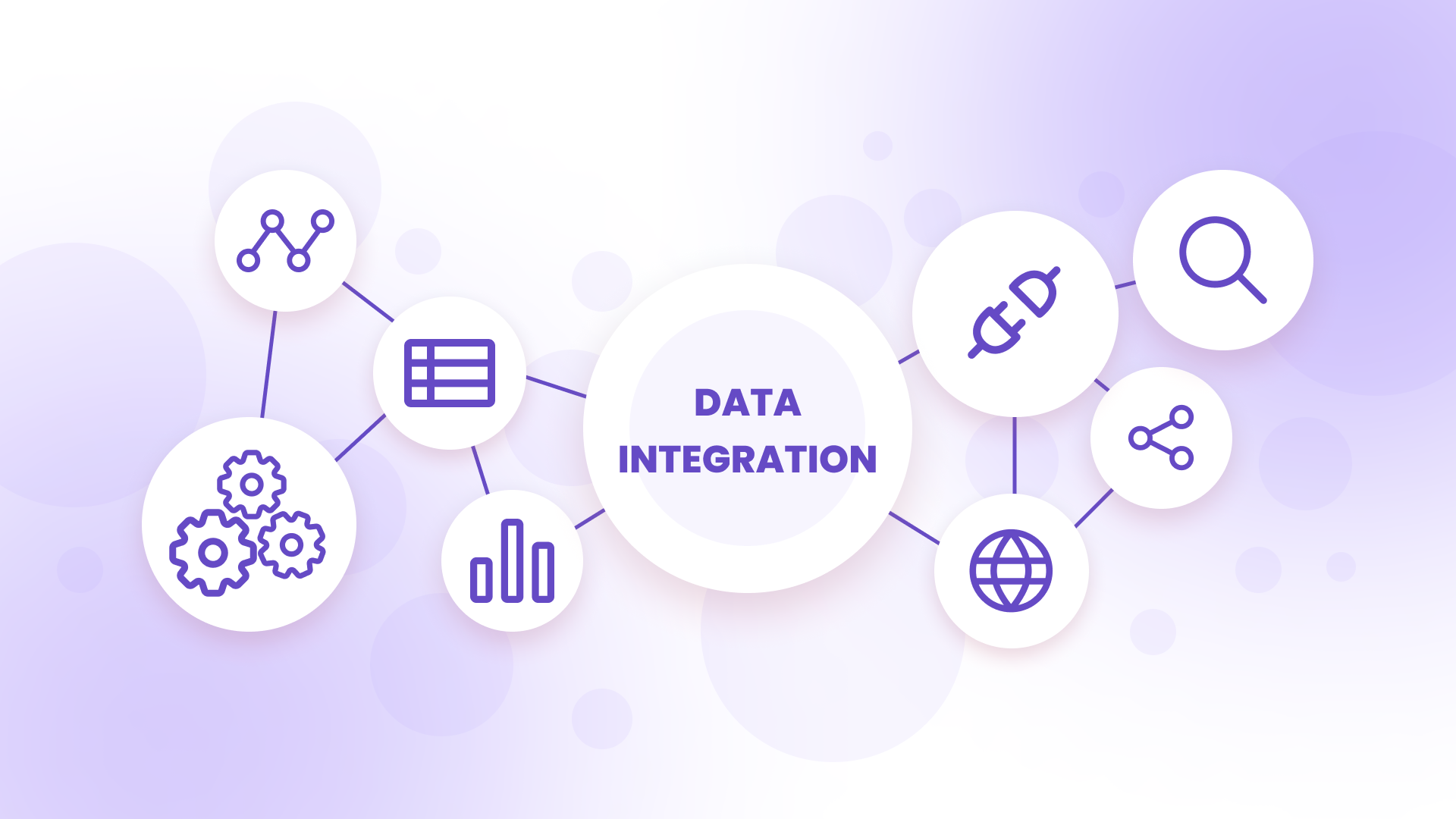
Hannah explained how she gets a comprehensive audience view.
“To begin with, I believe it’s important to understand that different types of data – social listening, audience demographics, surveys, search, etc – aren’t (or shouldn’t be) in competition with each other.  Each serves a purpose when building a holistic view of audiences, and as researchers, we need to leverage our expert understanding of these data sources when developing methodologies, while also considering our client and the strategic need driving the research, and the country that the audience is based in.”
Each serves a purpose when building a holistic view of audiences, and as researchers, we need to leverage our expert understanding of these data sources when developing methodologies, while also considering our client and the strategic need driving the research, and the country that the audience is based in.”
“For example, search data is a strong pillar in helping us to understand consumer needs in the UAE, where people prefer to seek information from official resources. In China, social listening may be more important, as people often turn to the community and try to learn from others’ experiences.”
Michael Brito, Global head of Analytics at Zeno Group, thinks “The more data sources about an audience, the better. This includes what I call “observable data" which is how audiences interact on social media channels. However, the insights can be much more impactful when coupled with primary or secondary research.”
Audience segmentation strategies
Audience data and integration are important, but the real magic happens when an audience is segmented into smaller groups to be studied. Industry experts have segmentation strategies they rely on to make campaigns more tailored and impactful.
Let’s explore Mike White’s segmentation strategy.
"Our recent project involved an internal transformation strategy for a leading tech firm operating in 111 countries. We began with assumptions and leveraged ChatGPT to get started. The client had a large existing audience through their Gartner partnership. We built territories based on segmentations and ran testing groups to gather feedback, determining the optimal approach. The creative process was crucial, running parallel to data analysis, ensuring we used insights to guide and inform our strategy."
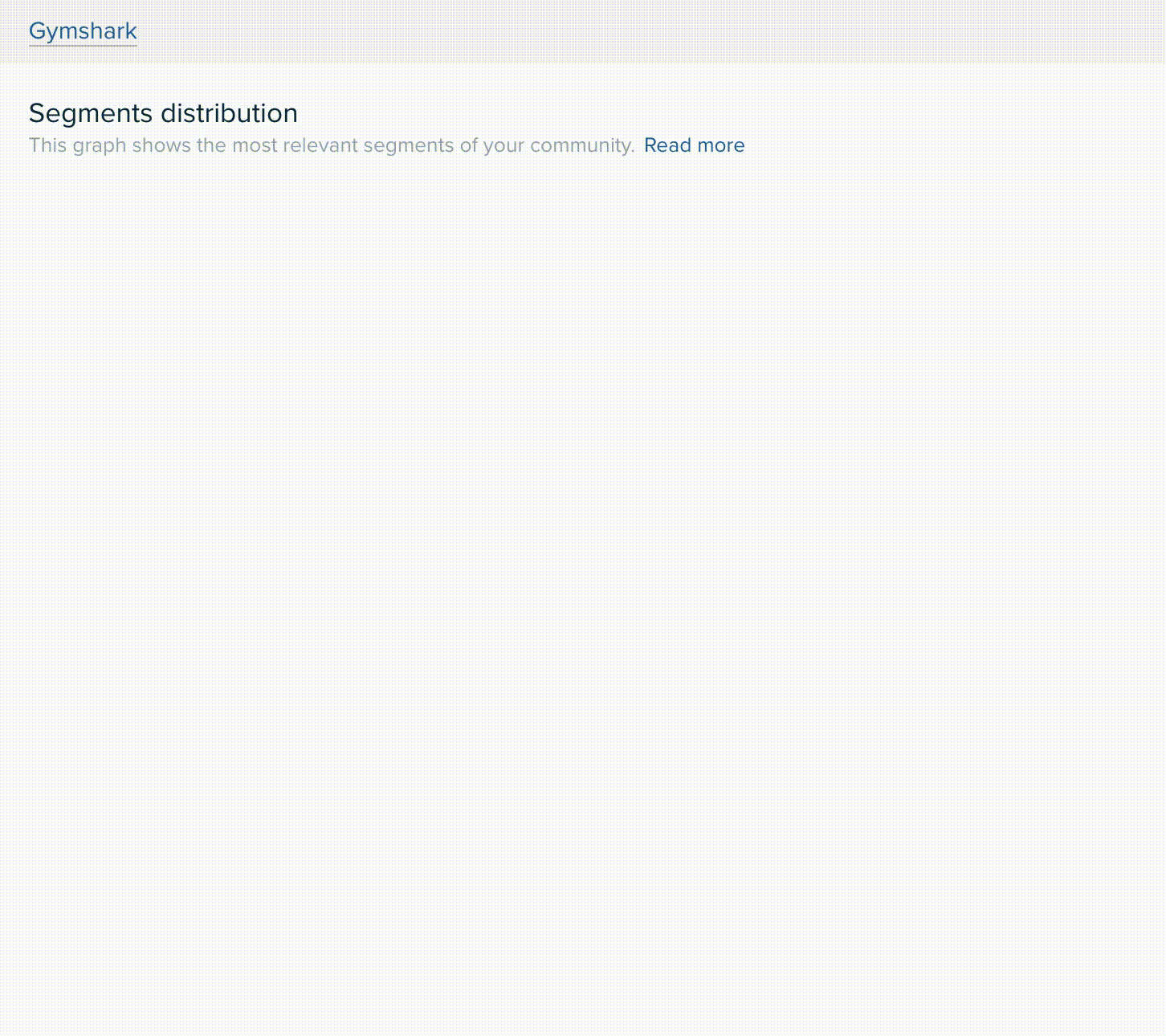
You can find a list of our top audience segmentation strategies here.
Client reporting and visualization
Audience intelligence tools are not only a value add for the agency but they often surface valuable insights for the client to action on as well. Many agencies pass on data-driven audience reports to their clients to highlight things like new opportunities for the client to capitalize on.
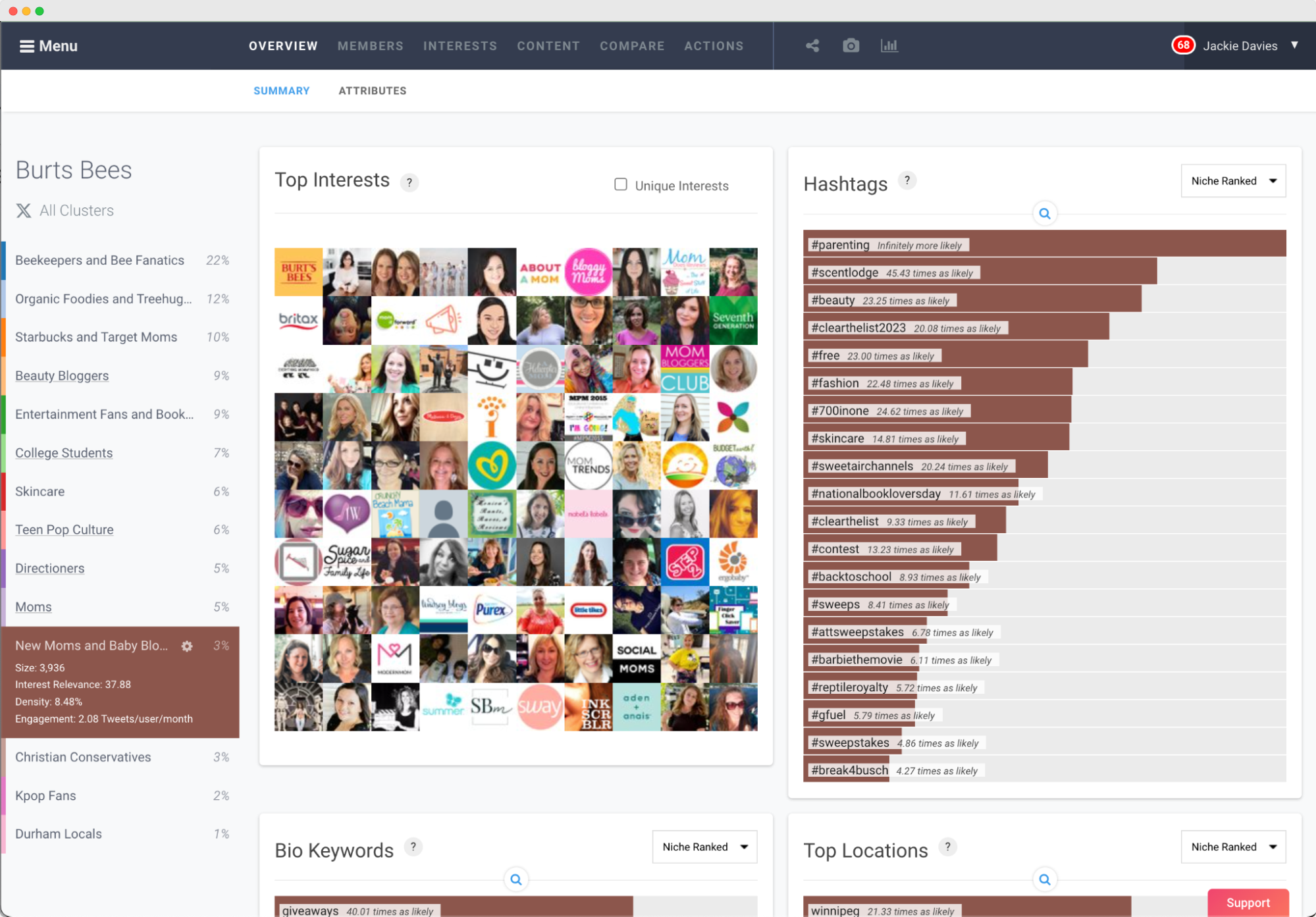
Every agency has its own way of creating and presenting these audience reports to their client.
Michael Brito is a “ firm believer in understanding the conversations of different audiences.” He says “When the data can be examined using text analysis or topic modeling, the insights can spark insight that moves the needle - customer's unmet needs, customer support issues, product development, and more.”
These reports and insights can be the reason your client stays loyal to your agency over another, so it's important to always be sharing audience intel with them, even if your agency can’t necessarily take action on it.
Take a walkthrough of this audience report in the Audiense platform and see how easy it would be to communicate audience insights with your client.
Navigating challenges with audience intelligence
Audience intelligence has changed the game for marketers, and it's integral for agency success, but it does not come without some downfalls and challenges. Let’s explore some of those.
Data privacy and compliance
Data privacy regulations are stressful for an agency because they are forever updating and changing.
“My team stays on top of data and privacy regulations by visiting the online GDPR compliance checklist on a monthly basis. Any new regulations are recorded and shared company-wide and put into practice immediately. This is necessary if our clients are giving us access to their first-party consumer data, however, this is rarely the case. Luckily, we source most of our audience data from Audiense, which already comes completely data compliant and doesn’t expose PII data.” - Andrew Tatton, CEO and Founder of Major Mojo Marketing
Staying ahead of the technological curve
The learning curve of audience intelligence tools can be small or steep depending on the tool. As a marketer you might feel that as soon as you get used to an audience intelligence platform, it updates or it adds new features that you have to then go and learn.
The real difference maker here will be the level of support your tool provides.
“The support team at Audiense is a game changer. If I am ever stuck on a project and need help customizing or interpreting an audience report, their team is on it. This also goes for feature updates. The tool is constantly evolving but we keep up with the changes because our support team does such a good job at communicating new features to us, and constantly showing us new ways to use the platform. If you are thinking about getting an audience intelligence platform, I would recommend looking at how their users rate their support level. Audience intelligence platforms are forever changing and advancing, which is why if you don’t have good support it can be hard to stay ahead of the technological curve.” - Andrew Tatton, Founder of Major Mojo Marketing
Educating teams and clients
Software support is great, but it is also important to be able to educate your team and your client on the value and implications of audience intelligence insights.
Ashley Pintaric, the CEO and Founder of Clarion Blue, explained how she educates her team and clients to foster a culture of data-driven decision-making.
“When we onboard new clients, we have them walk through a series of intake questions designed to gather insight into their brand and customers. If a client can’t provide answers or data, it opens the door for us to connect the dots for them by asking them deeper questions. “Why did you include this in your marketing message? Why do you feel that TikTok is essential to your strategy? What motivates your customers, and why?” Often they realize that they are not seeing results because they don’t know their audience as well as they thought. They begin to see that by operating based on assumptions, they don’t know who their customers really are and they’re missing crucial elements of their stories. These realizations make our clients open to pursuing other forms of audience intelligence beyond traditional methods like Google Analytics, social media analytics, or surveys (which are also important). Pulling in the right audience intelligence tools can help these clients fill in those missing pieces.” 
“Another way we demonstrate the value of audience intelligence is to offer evidence or case studies of clients that decided to utilize tools for deeper audience intelligence and after reviewing the customer insights provided through that intelligence, uncovered something that surprised them or altered their assumptions, which they then used to change their strategies and achieve successful outcomes. It’s human nature to make inferences and assumptions and we often don’t even realize when we’re doing so. By properly using audience intelligence tools like Audiense or SOPRISM, we can look past these assumptions and better understand the people we are trying to connect with. When we add customer insights to other forms of data and experience, we get the whole picture instead of part of it.”
“In addition to these methods, we continue to develop resources for customers or prospects to read on their own to better understand the value of audience intelligence. This includes understanding the platforms we use for informing our marketing strategies. Clarion Blue also has a dedicated page on our website, Audience Reports, for visitors to learn more about audience insight reports and how we use them to uncover valuable audience intelligence to build exceptional strategies. If we can educate clients on the benefits of audience intelligence they can make better decisions even when we are not around - this is a win for them and for us.”
Maximizing the impact of audience intelligence platforms
Now that we’ve reviewed the challenges we want to give you some tips, with the help of some experts, on how to maximize the impact of your audience intelligence platform.
Choose the right platform
The platform you choose can make all the difference, which is why you need to take the time and evaluate different tools to see which one is the best fit for what your agency needs and the kind of work that you do.
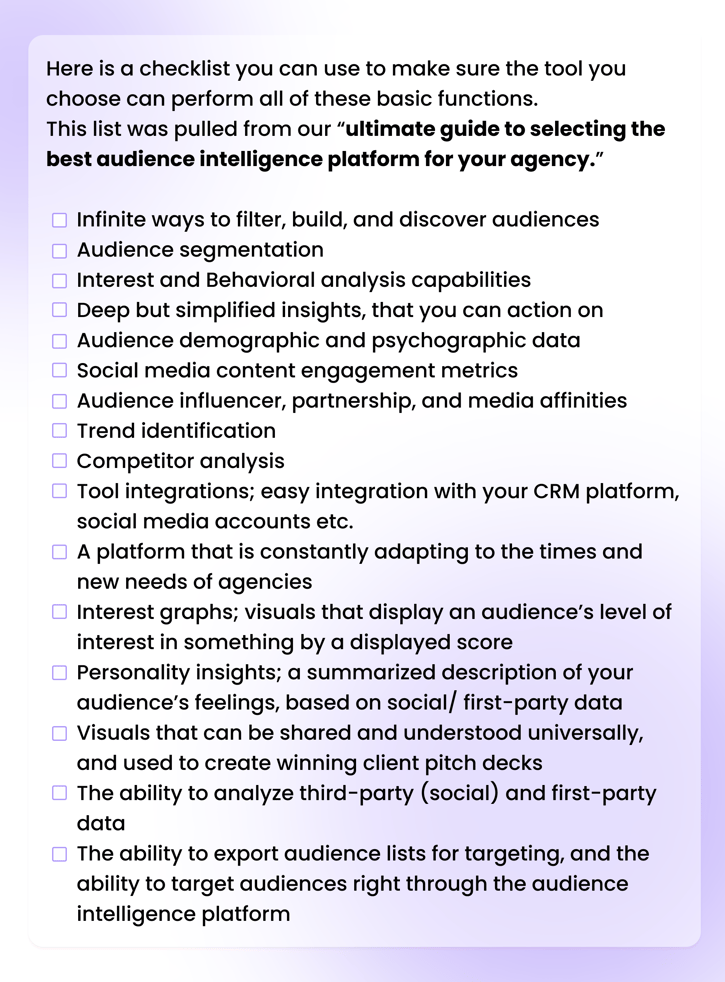
Customization and scalability
Beyond the list of criteria above, you want a tool that you can customize to your needs, and scale with your agency as it grows.
Hannah Humpherson, Account Director at Convosphere, explained why this is so important.
“Platform scalability and customisation are absolutely vital for a growing agency. In order to stay competitive, we need our tools to be highly adaptable, and to support us in answering hyper-specific customer needs and questions. If we can’t provide solutions that are targeted enough for their needs, they will simply find someone else who can. Beyond just delivering what our clients expect, to support client retention we also need to stay ahead of the curve, keeping an eye on emerging industry/consumer trends and offering our clients a forward-thinking, strategic viewpoint. Our audience intelligence platform must also be flexible enough to accommodate the needs of a growing team/business, with regard to user seats, data volumes etc.”
Audiense reports are highly customizable and allow you to ace any client pitch or project. Talk a walk through an Audiense report below.
.png?width=2602&height=1614&name=Alt%20%E2%80%9Can%20interactive%20walkthrough%20of%20the%20an%20audience%20intelligence%20report%20in%20Audiense%E2%80%9D%20(2).png)
![]() Integration with existing tools
Integration with existing tools
Platform integration with other tools is another important feature of a good audience intelligence platform. No platform can solve everything, or present every single data point you might need, which is why you want a tool that can hook up to other tools that can fill in any blanks.
Tools like Audiense and Meltwater are a great example of this. Meltwater is a media monitoring tool that can collect audiences to then be segmented and analyzed within the Audiense platform, without having to export or expose those audiences, because the two tools integrate seamlessly.
Success stories
Agencies who have found the right audience intelligence tool and have leveraged it to its full potential, have experienced a lot of agency success and remarkable results because of it.
Clarion Blue is a great example of this. Ashley Pintaric, the CEO and Founder shared a story of her success.
“Clarion Blue was approached by the founders of an online summit for survivors of religious trauma called Beyond The Wound. The summit had already pre-recorded 3 weeks’ worth of high-quality webinars focused on religious trauma and related topics, but had not laid a foundation for marketing or ticket sales.
It was only 2.5 months until the summit launch and we had to build a website, grow awareness, and secure enough registrants for the summit (which was our end goal).
As we built the strategy and website, we ran an audience report to better understand their target audience and segments. That report allowed us to study the presenters’ audiences along with key experts and high-profile influencers in the field.
The insights in the audience report helped us to adjust the brand messaging and content. For example, the customer insights helped us shape our general promotional video, which was meant to communicate that the summit was a relatable and safe space to heal from religious trauma.
The first video edit featured a brief clip of a group of people hugging. But as we studied the audience report, we noticed that this audience was risk averse and their highest interest included their pets, especially dogs.
We switched out the video clip of people hugging for one of someone connecting with their dog in a place of peace.
Within seven weeks, our campaign helped Beyond The Wound go from a completely unknown brand to the following:
- Grew social media presence on Instagram by 1,800%
- Sold over 400 tickets worldwide to audiences in Australia, New Zealand, South Africa, Europe, and North America
- Secured several more highly respected sponsors, including The Bible For Normal People.
- The event generated interest from influencers such as Brené Brown to speak at a future summit or participate as a sponsor.
- Earned a feature highlight in Religion News.
- After Clarion Blue designed and sent out a survey to attendees, over 95% of event respondents stated that the Beyond the Wound summit met or exceeded their expectations.”
The future of audience intelligence for agencies
Let’s take a look at what the future holds for audience intelligence, as it relates to agencies.
Emerging trends
Every agency should stay up to date with the emerging trends in the audience intelligence space. It could give your agency a competitive edge over another.
Hannah Humpherson enlightened us on the emerging trends agencies should prepare for in the coming years, in the audience intelligence space.
“Perhaps unsurprisingly, the increased dependence on AI to understand and interpret audience data. Artificial intelligence facilitates exponentially heightened sophistication when it comes to audience analysis, which will inevitably alter what we come to expect of audience intelligence platforms and, in turn, what our clients expect of us. It’s going to be very important to stay ahead of this trend, making sure that we adapt at every step of its evolution to remain competitive. I also think that AI is well placed to support another trend – that of audience intelligence based on automated, unstructured data analysis. AI has the potential to build an understanding of consumers that goes far deeper than that currently achievable via human review of customer verbatims, product reviews, social media posts etc., that will aid us immensely in the development of a strategically meaningful view of audiences.”
Innovations on the horizon
So what specific innovations are on the horizon for audience intelligence?
Andrew from Major Mojo Marketing tells us we can expect “predictive analytics to take a more significant role in audience intelligence. It will be used to predict future consumer behavior and identify trends even before they become trendy.”
“Personalization will also advance in audience intelligence platforms. Marketers will be able to deliver more and more tailored content to audiences, ensuring that everything they create resonates with them.”
Expert predictions
There is no doubt that audience intelligence will have a long-term impact on agency strategies and client relationships. But what will that impact look like?
Ashley Pintaric, the CEO and Founder of Clarion Blue answers with this:
“Before I can answer this question it’s important to understand why audience intelligence is so important. The evolution and development of AI that lets us access more and better data has also created pushback on anything that doesn’t resonate as authentically human. Therefore, it’s more important than ever for both agencies and businesses to understand how to use audience intelligence platforms that use AI to connect with their audiences and center them within their brand stories in a real and human way.
A brand's reputation and values are crucial to forming authentic bonds with customers. Think about how personal relationships work: the more time you spend with someone the more you learn about their values and purpose, which helps you understand how to connect with them in ways they appreciate.
Over time and through shared commonalities, those interactions form a natural progression of trust, familiarity, and value. In marketing, if agencies and businesses don’t understand their customers, they won’t be able to cut through the noise of their competition and connect in that natural, personable way that customers not only want, but expect.
Audience intelligence platforms provide insights at scale that reveal what deeply resonates with customers, including where they are, what they value, and how they communicate within their cultural context. This knowledge allows a brand to build a relationship with its customers on every level of the customer journey in ways that feel natural.
No matter the brand, people are the energy behind every business - staff and customers alike. Agencies and businesses that don’t adopt audience intelligence as a regular part of their business and marketing strategies will soon be left behind those who are using this technology to give the best overall picture of the people behind their products and brands.
If you don’t learn how to authentically connect with your audience, someone else will. The agencies that will get their clients exceptional results will be the ones who learn how to use AI driven audience intelligence platforms to understand humans rather than to just mimic their communications.”
Adopting the best practices
From speaking with our industry experts we’ve learned that audience intelligence will continue to transform and evolve the agency world.
Without the right audience intelligence tool, an agency can’t reach its full potential. But the work doesn't stop there. Agencies must leverage their audience intelligence tool to the fullest, and adopt industry best practices.
The audience intelligence world will only grow more complicated but more customizable, and if agencies don’t stay on top of the latest trends, they could fall behind their competitors.
We hope you take what you’ve learned here and apply it in the real world, on your next agency pitch or client project.
Try Audiense today, and see just how easy it is to act out industry best practices when you have the right tool, and a support team to help you leverage it.






